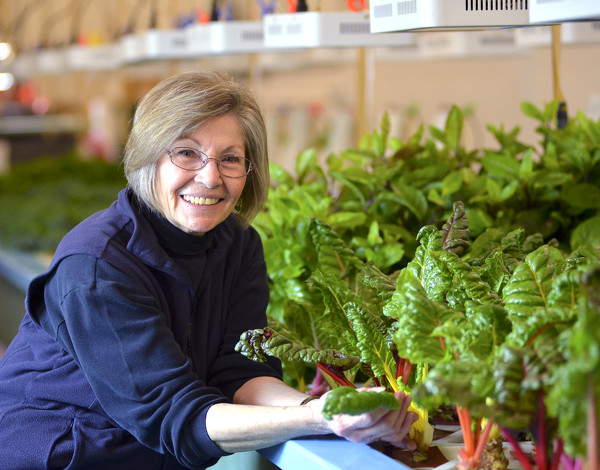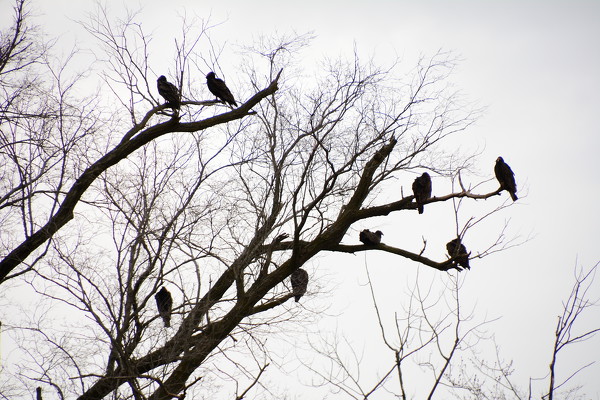Monday, March 25th, 2019
Aquaponics taking root at CALL Ministries facility
By William Kincaid

Photo by Dan Melograna/The Daily Standard
Charlene Huff poses with a variety of plants in the CALL Ministries Aquaphonics Bay on Tuesday in Celina.
CELINA - With a year's experience under their belts, CALL Ministries aquaponics co-managers Charlene Huff and Terry Chapman are now looking to fully optimize the in-house production of produce to better feed the hungry.
In the first two months of the year, the aquaponics division has produced almost as much as 2018's total yield, Chapman saiid.
The setup, installed in 2017 by former CALL Ministries Executive Director the Rev. Tim Clutter, is a self-contained ecosystem consisting of 1,800 gallons of water, nearly 200 yellow perch and floating trays capable of holding 660 plants, which when harvested are mixed together in a salad blend and provided to clients of the ministry's food pantry. CALL is located at 420 N. Brandon Ave., Celina.
"It generates a lot of enthusiasm for CALL pantry in general," executive director Homer Burnett said. "It's extremely nutritional, extremely tasty leafy greens."
Chapman and Huff, who got onboard last year, have made great strides in maximizing output through diligent application of the scientific method.
The now air-conditioned bay housing the aquaponics system is a veritable laboratory replete with a microscope, test beakers, sheets of data and other equipment.
"We're getting our whole system to be more sustainable so we have the same amount every week. I don't like running short. People in the pantry expect it, we're going to have it there," Chapman told the newspaper while pointing out system components.
Chapman, Huff and other volunteers are on pace to generate more vegetables in three months than they did all last year, a breakthrough they credit to numerous modifications.
"So far this year (through the end of February) we have harvested 222 pounds," Chapman said. Last year they took in 290 pounds of produce.
At this rate, Chapman is now gunning to consistently harvest 20 to 22 pounds a week for an annual total of at least 1,000 pounds. Such an amount would provide enough to fill 2,500 bags of salad blend that would retail for about $9,000, he said.
Kale, lettuce, romaine, Swiss chard, gynura procumbens and other mostly leafy green plants are placed on floating trays over a trough, where they're fed nutrient-rich water and bathed from above with LED lights.
"It is a good cancer-preventer eaten on a daily basis," Huff said about the gynura procumbens, noting it can be sauted like spinach or placed in salads and smoothies.
The system contains 20 floating trays each with 33 separate openings for a combined capacity of 660 plants. Chapman said the trays are nearly at full capacity.
The main trough is hooked up to a 500-gallon water tank filled with yellow perch. The fish are fed daily and their ammonia-rich solid waste passes through bacterial filtration to convert nitrites into nitrates, which are fed to the plants. The water then returns to the fish tank, creating a closed loop environment, according to a ministry brochure.
"The fish and their tank are maintained daily to provide a safe and healthy environment," the brochure reads. "Chemical analysis and visual observation are used to measure and adjust the water chemistry to the benefit of the fish, beneficial bacteria and plants."
Chapman and Huff have added a tank skimmer, extra biofilters and enhanced oxygen content of the system, leading to cleaner, healthier water for the fish. As such, the ministry went 91 days without a fish death.
"It's just made it a better environment for them," Chapman said. "We have made modifications now to make it work better."
Other changes include finding an ideal salinity level of 1.8 parts per thousand.
"Salt is like a natural preventative. Fungus, parasites, insects … they don't like salt water but we got the level adjusted so it don't affect the plants," Chapman said. "This is nothing more than a balancing act."
They inserted red silicone covers around the plants to keep out insects.
"When the plant grew and we harvested the leaves, residue would fall down in here (openings around the plants), get wet, rot. The rotting would attract the insects," Chapman explained.
They also rearranged the plants based on an eight- week growing cycle from germination to robust end product.
"We needed some order so that when we harvest every Wednesday we knew exactly the spot we were going to harvest in," Huff said. "Those would be the designated plants to get harvested."
The aquaponics project is truly a labor of love for the two co-managers who typically spend every day tending to the system.
"It's not work for us because we love it so much," Chapman said. In fact Chapman gets a kick out of any kind of bioscience, whether he's testing pH levels or getting an extreme close-up view of a spider under a microscope.
Huff, a master gardener in her own right, shares a similar passion for the volunteer work at the aquaponics bay.
"This is a happy place. In the dead of winter when it was 20 below zero you could come in here and see life, green life, and that's what motivates us quite a bit," she said. "Who would think that you'd go someplace, every day, seven days a week, and enjoy it as much as what we do?"
In addition to maximizing produce output, Chapman and Huff want to host more tours of the facility, especially for schools so the students can get a look at science in action. They also encourage other volunteers to step forward to test, harvest plants and feed fish.

Photo by Dan Melograna/The Daily Standard
Terry Chapman, who is illuminated by pink LED lights, shows the improved filtration system for fish at the CALL Ministries Aquaphonics Bay.

Photo by Dan Melograna/The Daily Standard
Charlene Huff shows the roots from a gynura procumbens growing at the CALL Ministries Aquaphonics Bay.



